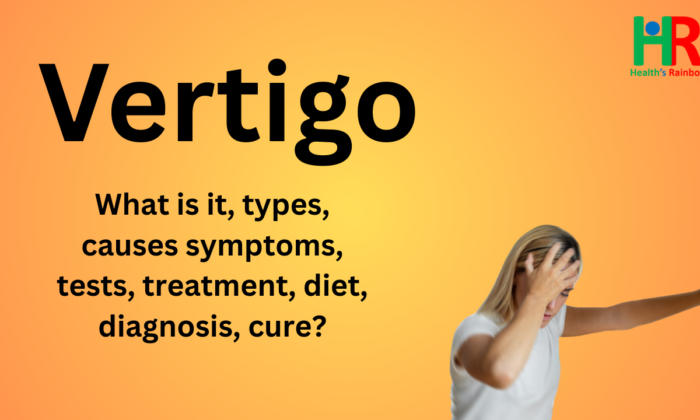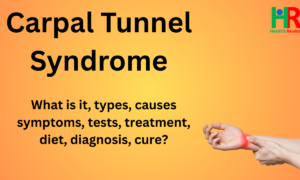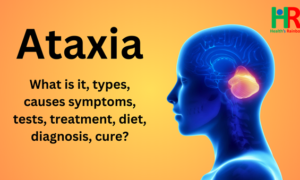
Definition of Vertigo
Vertigo is a false sensation of movement, typically a rotational or spinning sensation. It results from a disruption in the signals sent to the brain by the vestibular system, which includes the inner ear and its connections to the brainstem and cerebellum, responsible for maintaining balance and spatial orientation.
Types of Vertigo
Vertigo is broadly classified into two main types based on the location of the underlying problem:
- Peripheral Vertigo: This is the most common type and arises from problems in the inner ear or the vestibular nerve (the nerve that connects the inner ear to the brain).
- Benign Paroxysmal Positional Vertigo (BPPV): Brief, intense episodes of vertigo triggered by specific head movements.
- Meniere’s Disease: A disorder of the inner ear characterized by episodes of vertigo, ringing in the ears (tinnitus), hearing loss, and a feeling of fullness in the ear.
- Vestibular Neuritis (or Labyrinthitis): Inflammation of the vestibular nerve or the labyrinth (inner ear), often caused by a viral infection, leading to sudden, severe vertigo.
- Acoustic Neuroma: A non-cancerous growth on the vestibulocochlear nerve (which includes the vestibular nerve), causing hearing loss, tinnitus, and balance issues.
- Central Vertigo: This type arises from problems in the brain, particularly in the cerebellum or brainstem, which are involved in processing balance signals.
- Migraine-Associated Vertigo: Vertigo that occurs with or is triggered by migraine headaches.
- Stroke or TIA: Damage to areas of the brain that control balance.
- Multiple Sclerosis (MS): Damage to the central nervous system that can affect balance pathways.
- Brain Tumors: Can compress or damage brain regions involved in balance.
- Cerebellar Ataxia: As mentioned previously, problems with the cerebellum can manifest as vertigo and imbalance.
Symptoms of Vertigo
The primary symptom of vertigo is the sensation of spinning or moving. Other associated symptoms can include:
- Nausea and Vomiting: Commonly accompany severe vertigo.
- Balance Problems: Difficulty walking straight, unsteadiness.
- Dizziness: A general feeling of lightheadedness or faintness (distinct from the spinning of vertigo).
- Nystagmus: Involuntary, rapid eye movements (often seen during a vertigo episode).
- Tinnitus: Ringing or buzzing in the ears (especially with Meniere’s disease).
- Hearing Loss: Can occur with inner ear conditions like Meniere’s disease.
- Headache: Particularly with migraine-associated vertigo or central causes.
- Fatigue: Resulting from the discomfort and effort to maintain balance.
- Sensitivity to Light and Sound: Common with migraine-related vertigo.
Causes of Vertigo
The causes of vertigo are diverse and often relate to disruptions in the vestibular system:
- Inner Ear Problems:
- Benign Paroxysmal Positional Vertigo (BPPV): Caused by dislodged calcium carbonate crystals (otoconia) in the inner ear canals.
- Meniere’s Disease: Believed to be due to an abnormal fluid buildup in the inner ear.
- Vestibular Neuritis/Labyrinthitis: Inflammation, usually viral, affecting the inner ear or vestibular nerve.
- Brain Conditions:
- Stroke or TIA: Affecting the cerebellum or brainstem.
- Migraine: Can trigger vertigo episodes even without a headache.
- Multiple Sclerosis (MS): Lesions in the brain that disrupt balance signals.
- Brain Tumors: Especially those affecting the cerebellum or brainstem.
- Head Trauma: Can damage the inner ear or brain structures.
- Certain Medications: Some drugs, such as certain antibiotics (aminoglycosides), anticonvulsants, or sedatives, can have ototoxic effects or affect the central nervous system, leading to vertigo.
- Infections: Viral infections affecting the vestibular nerve (e.g., herpes zoster oticus).
- Circulatory Problems: Reduced blood flow to the brain or inner ear.
- Anxiety and Panic Attacks: Can sometimes mimic or exacerbate vertigo symptoms.
Who Can Suffer from Vertigo?
Vertigo can affect anyone, though some conditions are more prevalent in certain age groups or demographics:
- Adults: BPPV is more common in older adults. Meniere’s disease typically affects adults between 40 and 60.
- Elderly: Increased risk of BPPV, stroke, and circulatory problems that can cause vertigo.
- Individuals with Migraines: Prone to migraine-associated vertigo.
- People with certain medical conditions: Such as MS, stroke, or head injury.
Diagnostic Tests for Vertigo
Diagnosing the cause of vertigo often involves a combination of tests:
- Medical History and Neurological Examination: Detailed questioning about symptoms, triggers, and a physical exam to assess balance, coordination, eye movements (looking for nystagmus), and hearing.
- Positional Tests:
- Dix-Hallpike Maneuver: Used to diagnose BPPV by observing eye movements when the head is moved into specific positions.
- Audiometry (Hearing Test): To assess hearing loss, especially if Meniere’s disease is suspected.
- Videonystagmography (VNG) or Electronystagmography (ENG): Tests that measure eye movements to assess the function of the vestibular system.
- Caloric Stimulation: Part of VNG/ENG, where warm and cold water or air are introduced into the ear canal to stimulate the inner ear and observe eye responses.
- Rotary Chair Test: Measures eye movements while the patient is seated in a rotating chair, providing information about vestibular system function.
- Brain Imaging:
- MRI (Magnetic Resonance Imaging): To rule out central causes like stroke, MS, or tumors.
- CT (Computed Tomography) Scan: May be used in acute cases, especially after head trauma.
- Blood Tests: To check for infections, inflammation, or other systemic conditions that could contribute to vertigo.
Stages of Vertigo
Vertigo isn’t typically categorized into “stages” in the same way as progressive diseases. Instead, it’s often described by the frequency, intensity, and duration of episodes:
- Acute Episodes: Sudden onset, often severe, and can last from seconds to days. (e.g., BPPV, Vestibular Neuritis)
- Recurrent Episodes: Vertigo attacks that happen repeatedly over time, with periods of remission. (e.g., Meniere’s Disease, Migraine-Associated Vertigo, recurrent BPPV)
- Chronic Dizziness/Imbalance: Persistent feelings of unsteadiness or lightheadedness, sometimes after an acute vertigo episode has resolved (e.g., Persistent Postural-Perceptual Dizziness – PPPD).
Treatment of Vertigo
Treatment for vertigo depends heavily on the underlying cause:
- Addressing the Underlying Cause:
- BPPV: Canalith Repositioning Maneuvers (e.g., Epley maneuver): A series of head movements designed to reposition the dislodged crystals in the inner ear. This is often highly effective.
- Meniere’s Disease: Dietary changes (low-sodium diet), diuretics, medications to suppress vertigo (e.g., anticholinergics, antihistamines), and in severe cases, injections or surgery.
- Vestibular Neuritis: Medications to suppress nausea and vertigo (e.g., antihistamines, benzodiazepines), and sometimes corticosteroids.
- Migraine-Associated Vertigo: Migraine prevention medications and lifestyle adjustments.
- Stroke/TIA, MS, Tumors: Treatment focuses on the primary neurological condition.
- Symptom Management:
- Medications:
- Antihistamines (e.g., meclizine): To reduce spinning sensation and nausea.
- Benzodiazepines (e.g., diazepam): To suppress vestibular activity, used short-term due to sedative effects.
- Anti-nausea medications (antiemetics): To relieve nausea and vomiting.
- Vestibular Rehabilitation Therapy (VRT): A specialized form of physical therapy designed to retrain the brain to compensate for vestibular deficits, improving balance and reducing dizziness.
- Medications:
- Lifestyle Modifications and Home Care:
- Avoiding sudden head movements.
- Getting enough rest.
- Staying hydrated.
- Managing stress.
- Identifying and avoiding triggers (e.g., certain foods, bright lights for migraine-related vertigo).
Best Diet for Vertigo
While diet doesn’t directly “cure” most types of vertigo, it can play a role in managing conditions like Meniere’s disease and supporting overall brain health:
- Low Sodium Diet: Crucial for Meniere’s disease to help manage fluid balance in the inner ear.
- Hydration: Adequate water intake is essential.
- Balanced Diet: Emphasize whole foods, fruits, vegetables, lean proteins, and healthy fats.
- Limit Caffeine and Alcohol: These can sometimes exacerbate vertigo symptoms, especially in Meniere’s disease.
- Consistent Meal Times: To help regulate blood sugar, which can sometimes influence dizziness.
Prevention of Vertigo
Preventing vertigo largely depends on preventing its underlying causes:
- For BPPV: While not entirely preventable, being mindful of sudden head movements, especially when lying down or getting up, can sometimes help.
- For Meniere’s Disease: Adhering to a low-sodium diet and avoiding triggers can help prevent attacks.
- Preventing Stroke/TIA: Managing blood pressure, cholesterol, diabetes, and maintaining a healthy lifestyle.
- Preventing Head Trauma: Wearing helmets and using seatbelts.
- Managing Migraines: Following a migraine prevention plan if prone to migraine-associated vertigo.
- Avoiding Ototoxic Medications: Discussing potential side effects with your doctor.



